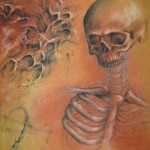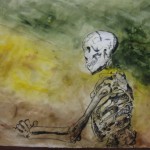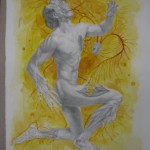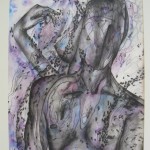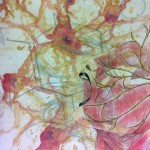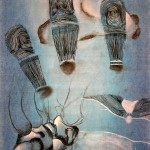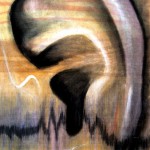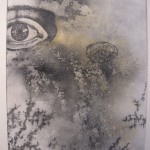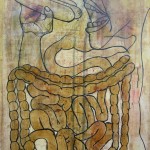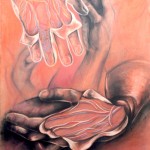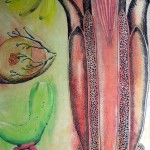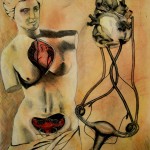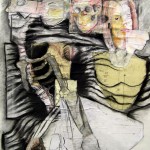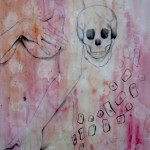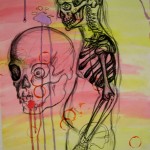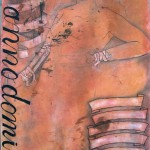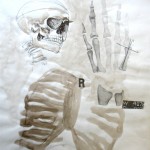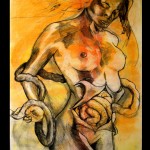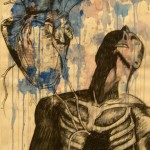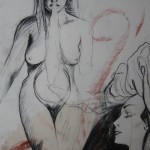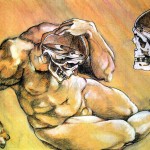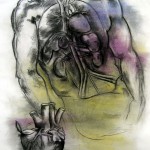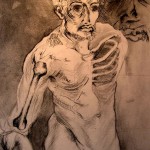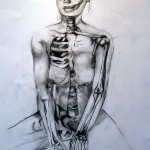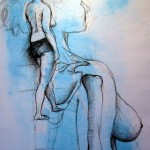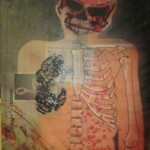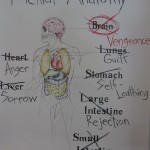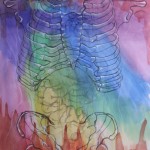- Aeden Arcane
- Valerie Herrero
- Jessica Barton
- Mariann Bisaccia
- Adam Glenn
- Seth Le Donne
- Katherine Bodner
- Julie Gamble
- Sandra Cress
- Matt Scarfo
- Colin Medved
- Craig Smith
- Mary Madden
- Andrew Novel
- Nicole Phillips
- Andrea Comisso
- Alysha Meyers
- Rachelle Conn
- Karri Roberts
- Janine Williams
Transparent Body
Possible interpretations could include: the physical body with bones or organs; an analysis of internal parts, systems, and processes; visual representations of the five senses.
Research, sketches, and/or 1st layer presented for class critique: 2nd Week
Project and written statement due: 3rd Week
Suggested Artists and books for visual research: Francis Bacon, Kiki Smith, Eva Hesse, Damien Hurst, Eadweard Muybridge, Leonardo Da Vinci, Vesalius,
Images from the history of science and medicine.
O’Malley and Saunders. Leonardo Da Vinci on the Human Body: The Anatomical, Physiological, and Embryological Drawings. New York: Wings Books, 1982
Strauss, Walter. Albrecht Durer: the Human Figure. The Complete Dresden Sketchbook. New York: Dover, 1927
Hale, Robert Beverly. Drawing Lessons from the Great Masters. New York: Watson-Guptill, 1965
Robin, Harry. The Scientific Image: from Cave to Computor. New York: Abrams, 1992
Kemp, Martin and Wallace Marina, Spectacular Bodies: The Art and Science of the Human Body
from Leonardo to Now. Berkeley: U. of Cal. Press, 2000
Rifkin and Ackerman. Human Anatomy (from the Renaissance to the Digital Age). New York: Abrams, 2006
Muybridge, Eadweard. The Human Figure in Motion. New York: Dover Publications, 1955
Optional Project for 1st Level Advanced Drawing
Transparent Body: Master Copy with Skeleton
Size 18 x 24 minimum (the larger the better). Medium: Drawing paper or Arches hot-pressed watercolor paper (smooth). Charcoal pencil on powdered charcoal ground.
Objectives: To study the skeleton and its placement in relation to the muscles and flesh. To improve drawing skills by copying the techniques of a master draftsman.
Instructions: Part 1 Go to the library and find a nude figure drawing by a famous artist that clearly illustrates the skeletal and or muscular systems. The figure may be male or female, in full or half figure. Make a good, extra large copy or high resolution scan of the image Crop one edge of the master copy (or the drawing paper) so that both formats correspond (7” x 10” = 21” x 30”). Draw (or fold) a grid of equal-sized units on the master copy. Then draw an equivalent, proportional grid on your drawing paper. (If there are 16 rectangles on the master copy, there will be 16 rectangles on your paper.) Use this grid to transcribe the master drawing onto your paper. Pay special attention to the quality of line and try to copy the markmaking. Begin very lightly with a hard or medium charcoal pencil and sketch out the entire figure before adding any details or shading.
Part 2
With the figure accurately sketched out in line, you will now try to fit the skeleton inside of it. Using the skeleton models in Vulcan, or skeleton reproductions from various angles, sketch in the bones very loosely and lightly as gesture drawings. Don’t worry too much about the exact shape of the bones in the beginning. Try to locate the points where the bones come close to the surface of the skin to find their correct positions. Once the skeleton is sketched out, choose an area of focus to develop in detail with tonal markmaking. The rest of the figure and skeleton may remain as pure line.
